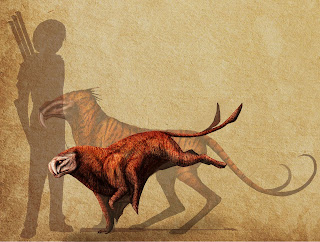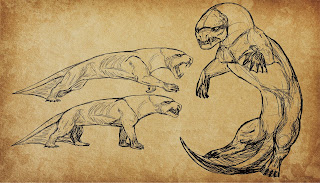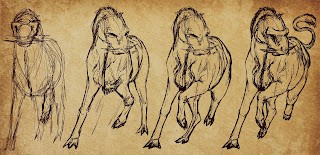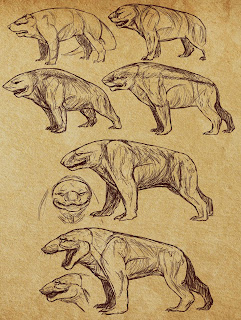Overview
The guiding theme of this creature was eventually divergent evolution. The starting point was a lingering idea of a cuttlefish/panther creature that could camouflage perfectly, and while I was floundering with design ideas I watched a free video offered on R.J. Palmer's skillshare page, where he freely sketched creature designs. His commentary was inspiring and the first of these sabrecats was sketched, initially with intent to replace the cuttlefish/panther, but then that one was soon sketched as a differently evolved creature in the same family.
Ribas is actually the reversal of an arabic name, Sabir, which means patient; hypothetically this could be taken as Ribas meaning impatient/quick, apt for the fast, sleek, cat-like creature. Diribas is the divergent relation, named second as its camouflage would have meant it being discovered second.
Inspiration
Creatures:
- Cheetah
- Tiger
- Lion
- Black Panther
- Colugo
- Coati Mundi
- Raccoon
- Tanuki/Raccoon Dog
- Ring-tailed Lemur
- Turkey Vulture
- King Vulture
- Lammergeier Vulture
- Secretary Bird
- Grasshopper
- Cuttlefish
- Octopus
- Velociraptor (Extinct)
Process
Ribas developed alongside Diribas in a feedback loop - initially Ribas was to replace the other, but it soon became apparent they were both similar/dissimilar enough to be in the same family. Sketches and inspiration were from various sources as I floundered in places and sped ahead in others.
Traditional sketches for Diribas, the cuttlefish/panther. Ideas were present (text is merely thoughts on teeth slotting into place like snake fangs, extra eyelids for camouflage, and what to do with the webbing on the legs), but as a whole there was no stand-out design.
Digital sketches for Diribas. There is a clear fight between long or short legs, which the 'divergent evolution' theme solved. The coloured Ribas sketch in the corner was added later, to keep colours and anatomy in mind when choosing a final design to stand beside him
I watched the first of R.J. Palmer's videos on Skillshare to see if it was worth buying the course (once I am done with this mini-project I will use it within my next one as it seems useful). The technique shown was to simply draw, and find shapes or ideas that seemed interesting. He had no goal in mind, merely drawing dinosaurs, dragons, and prehistoric-looking mammals from imagination, and I imitated the concept. A few parts of his designs struck ideas in me (he tested horns as teeth and teeth as horns) and Ribas came as a result of looking at the longer-legged Diribas sketches, which I hadn;t wanted to abandon.
Sketches using R.J. Palmer's tutorial. Eventually, favoured Diribas sketches were placed in the top right, and sketched around. The bottom bull-inspired creatures sparked a different creature's design.
Ribas sketches (some from the previous sheet). A more developed hunter than Diribas. Grasshopper-like back legs quickly took hold, to both give the creature an interesting feature and have powerful jumps.
Chosen poses and final lineart for both creatures. Front view headshots keep the scale of the features in mind. Musculature is visible as I wanted to make sure the arms worked correctly. Muscles are based on those of a panther. Key features link the two animals - the six limbs, split tail, exterior fangs, and bald faces.
A test to see how other creatures were lining up in terms of size. The sharkdogs were reduced after this test, as were Ribas and Diribas.
Ribas, the treetop predator.
Diribas, the camouflaged ambush predator.
Final creatures.
Design Notes - Ribas:
- Long, grasshopper-inspired back legs allow for incredibly powerful leaps, while cat-like front legs aid in the landing
- Tiger stripes for camouflage in long grass or canopy leaves, fairly short fur
- Canine fangs are exterior
- Crest-like quills are taken from the secretary bird, linking in with long legs and tree-dwelling habitats, as well as suggesting strong kicks
- Omnivore, has some tolerance for envenomed prey killed by Diribas
- Large nasal cavity - they communicate in very low frequencies, thrumming in the nose and throat
- Sleek design suggests fast movement and quick reflexes, likely to hunt birds and tree-dwelling mammals, though they would not be opposed to running across plains and bringing down larger animals as a social pack
- Secondary arms have developed nimble fingers and thumbs, like a raccoon - used to grip on difficult surfaces (generally tree trunks) and carry objects
- Fairly magpie-like tendancies; Ribas will often collect interesting or shiny objects and relocate them to caches up in the trees
- Very social, though they tend to sleep in separate trees (unless the weather is wet or cold). Guards (taken in turn) sit on the fringes of the sleeping area and communicate in extremely low frequencies humans cannot hear
Design Notes - Diribas:
- Shorter, squatter body, lower to the ground
- No fur, skin is thick (with some protective blubber). Texture is like that of an octopus, made up of pigments and laced in a way it could form itself into other textures, like rock or moss or bark
- Less developed secondary limb, more vestigial - simply used to better move webbing around when camouflaged to provide the best effect
- Split tail is reminiscent of squid tentacles to show its origin
- Face is less developed, more mask-like than Ribas' skin-covered face. Exterior fangs are made of bone
- Highly venomous. Can infect through touch, or by biting. Biting is more potent, while touch is useful to keep prey unaware it has been infected
- Omnivore, eats whatever it has killed due to having full immunity to its venom's effects
- Tends to stay on the forest floor in thick vegetation, or alongside cliffs. Rarely strays into plains
Reflection
- This concept took a while to complete, but I learnt a lot from following it through and not abandoning the design.
- Bringing current ideas into whatever sketching method is being used (like R.J Palmer's, or traditionally, for example) gave a different feel to the creature. It was good to ground it with previous sketches again.
- Although I feel these creatures aren't too far from what is typical fantasy fodder (six legs, sabretooth, cat-like), the fact they co-exist together and are related evolution-wise makes them feel like a more significant step in a new direction.
- Ribas originally was much less detailed. Once I completed Diribas, who needed significant detail to produce octopus-like skin, I returned to the other creature and completed them to the same level of detail. Looking back, the version I was originally happy with was very scrappy and definitely needed the improvement.
- These two were the main focal point for my MA poster, and held up very well.
- One of my favourites of this mini-project so far.























